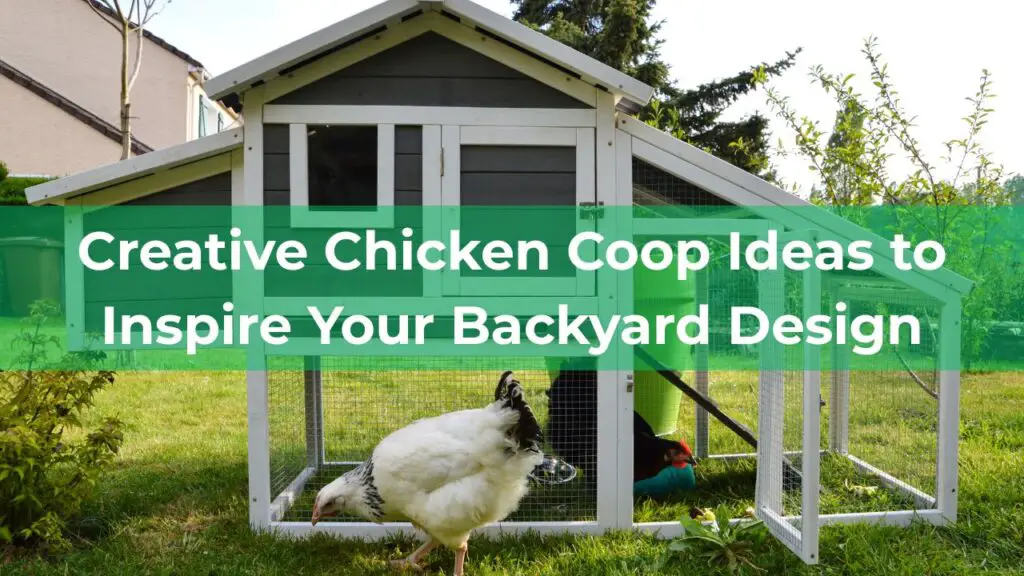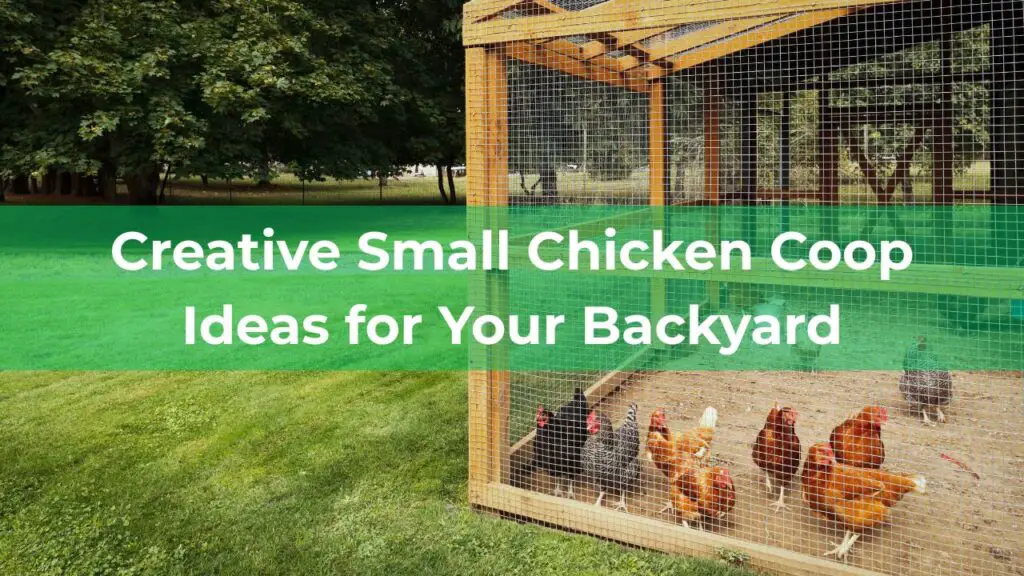Creating a small garden layout can be a fun and rewarding project, even if space is limited. With a little creativity and planning, you can transform any compact area into a lush and inviting green space. This guide will help you utilize your available space effectively, making the most of every inch to grow plants, flowers, or even an herb garden, all while keeping things stylish and functional.
Creating Defined Zones
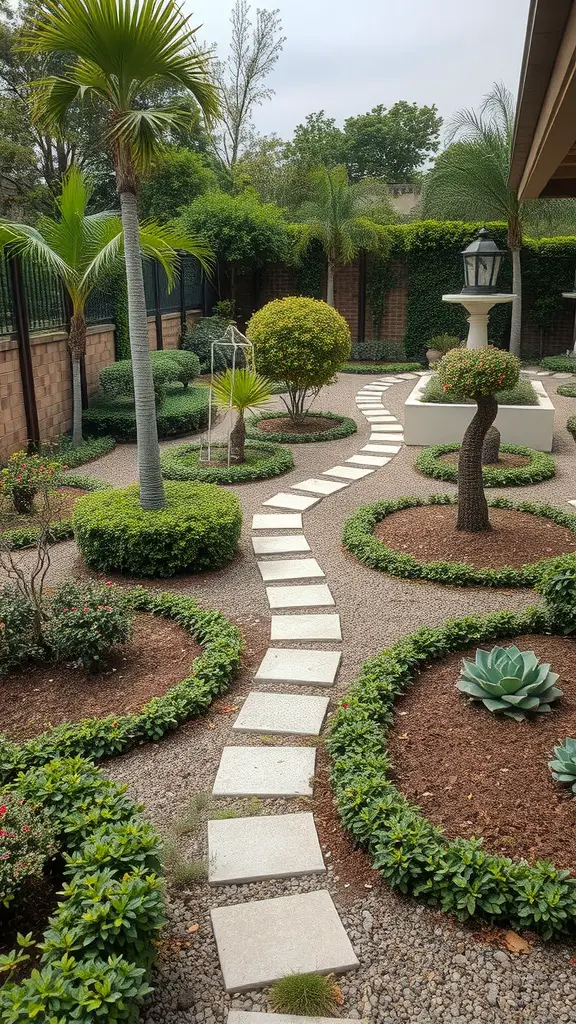
In a small garden, creating defined zones can make a big difference. This image shows a lovely layout with distinct areas that guide the eye and create a sense of order. The pathway made of stepping stones leads you through the garden, inviting exploration.
The circular beds filled with greenery and the occasional succulent add texture and interest. Each zone has its own character, making the space feel larger and more inviting. The use of different plant heights, like the tall palms and the low shrubs, adds depth to the design.
Incorporating features like a lantern or a small fountain can also enhance these zones. They serve as focal points that draw attention and create a peaceful atmosphere. This layout not only looks great but also encourages you to enjoy each area of the garden.
Incorporating Raised Beds
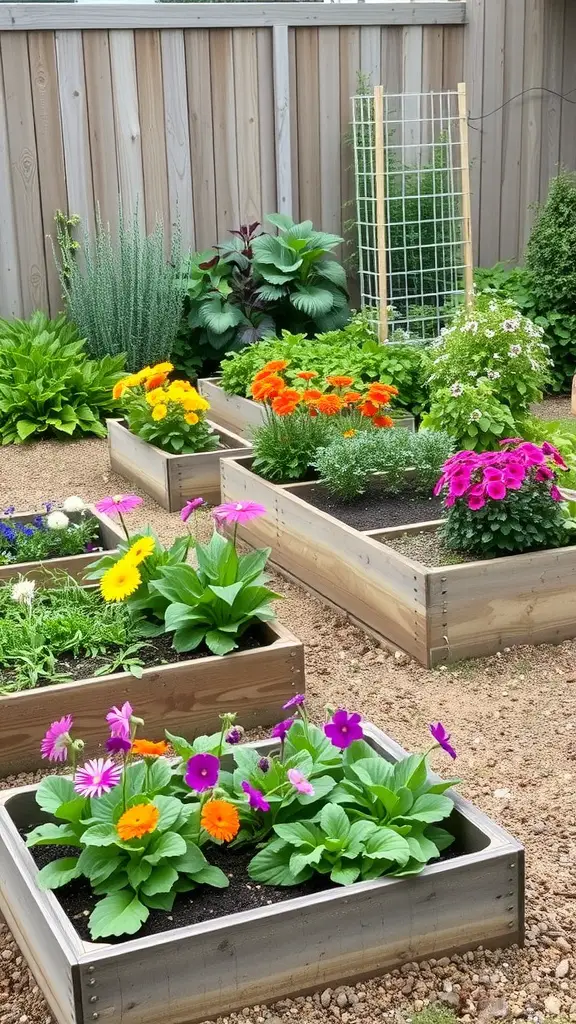
Raised beds are a fantastic way to organize a small garden. They create defined spaces that make it easy to manage your plants. In the image, you can see several wooden raised beds filled with colorful flowers. This setup not only looks great but also helps with drainage and soil quality.
Each bed is filled with a variety of plants, showcasing how you can mix colors and textures. The vibrant flowers, like marigolds and geraniums, add a cheerful touch to the garden. Raised beds allow for better access, making it easier to tend to your plants without bending over too much.
Another benefit of raised beds is that they can be customized to fit your space. You can create different shapes and sizes depending on your garden’s layout. The vertical trellis in the background is a smart addition, providing support for climbing plants and maximizing vertical space.
Overall, incorporating raised beds into your small garden layout can enhance both the beauty and functionality of your gardening space. They offer a practical solution for growing a variety of plants while keeping everything organized and visually appealing.
Utilizing Container Gardening
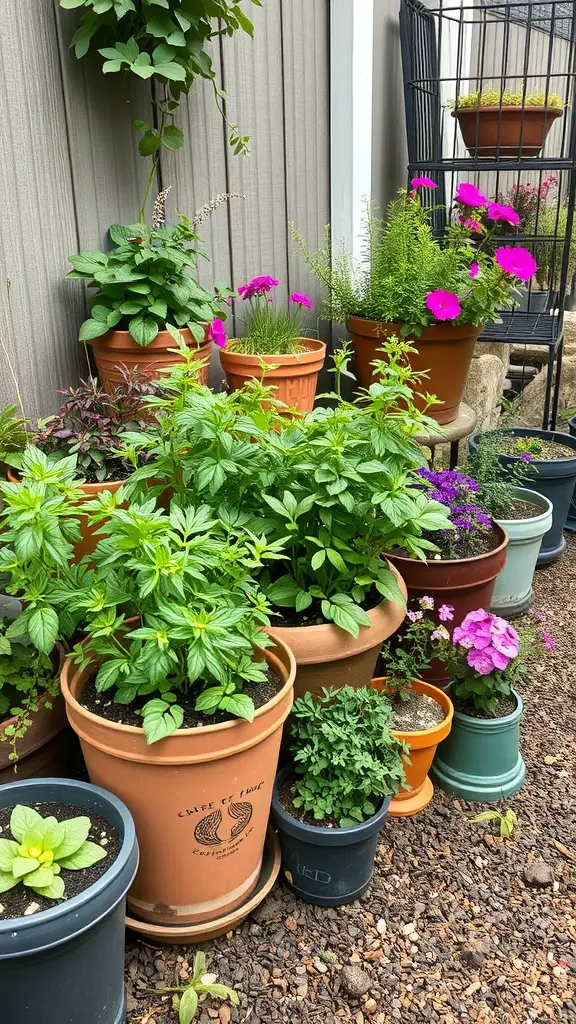
Container gardening is a fantastic way to make the most of a small space. The image shows a vibrant collection of potted plants, each adding its own charm to the area. You can see a mix of herbs, flowers, and leafy greens, all thriving together.
Using containers allows you to arrange plants in a way that suits your style. You can play with colors and heights, creating a visually appealing layout. The pots vary in size and shape, which adds character and interest to the garden.
One of the best parts about container gardening is the flexibility it offers. You can easily move pots around to find the perfect spot for sunlight or shade. This adaptability is perfect for small gardens where space is limited.
Moreover, container gardening makes it easier to manage soil and watering needs. Each pot can have its own mix, tailored to the specific plant inside. This way, you can ensure that each plant gets exactly what it needs to thrive.
Selecting the Right Plants
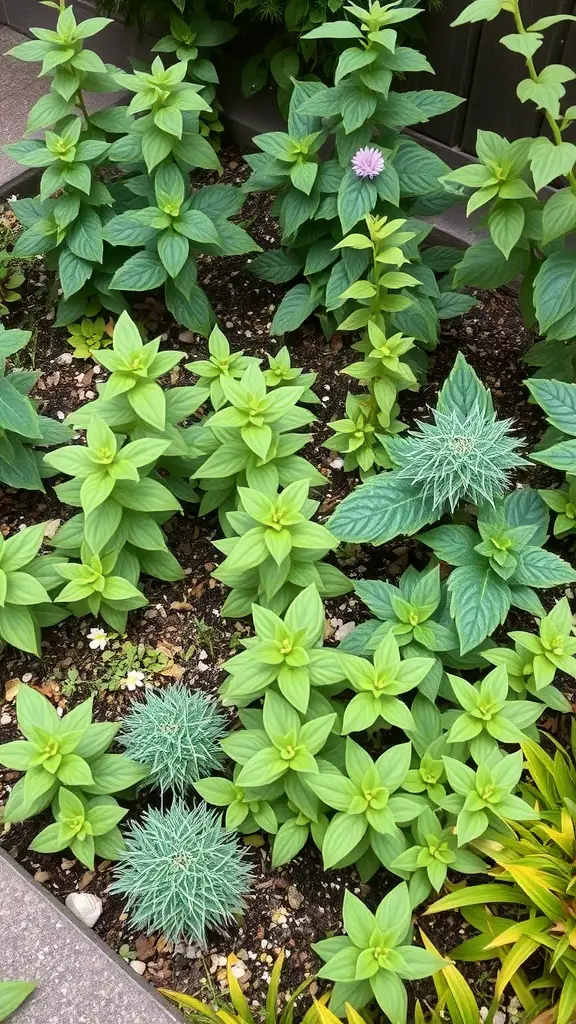
Choosing the right plants for a small garden can be fun and rewarding. The image showcases a vibrant mix of greenery, with various plants thriving together. Notice how the different shades of green create a lively atmosphere. This variety not only adds visual interest but also supports a healthy ecosystem in your garden.
When selecting plants, think about their growth habits. Some plants, like the taller ones in the image, can provide height and structure. Others, such as the low-growing varieties, can fill in gaps and create a lush carpet effect. Mixing heights and textures will make your garden feel fuller and more dynamic.
Consider the sunlight and space available in your garden. Some plants need full sun, while others thrive in shade. The plants in the image seem to enjoy a good balance, which is key to their health. Make sure to group plants with similar light and water needs together for easier maintenance.
Don’t forget about color! The single pink flower in the image adds a lovely pop against the green foliage. Incorporating flowers can attract pollinators and bring joy to your garden. Think about seasonal blooms to keep the garden lively throughout the year.
Lastly, choose plants that suit your gardening style. Whether you prefer low-maintenance options or enjoy tending to your plants regularly, there’s something for everyone. Happy planting!
Creating a Cozy Seating Area
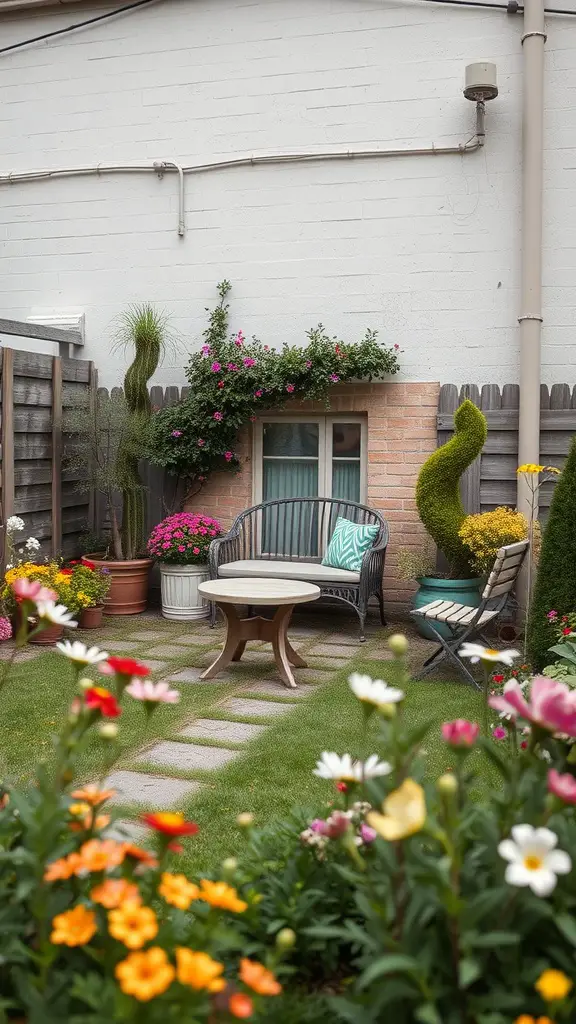
A small garden can be a perfect spot for relaxation, especially when you create a cozy seating area. The image shows a charming setup with a comfortable bench and a round table, inviting you to sit and enjoy the outdoors.
Surrounded by colorful flowers and greenery, this space feels welcoming. The vibrant blooms add a cheerful touch, making it an ideal place to unwind. A few potted plants enhance the natural feel, while the stone pathway guides you through the garden.
Choosing the right furniture is key. The bench offers a comfortable spot for reading or chatting with friends. The table is perfect for holding drinks or snacks. You can even add some cushions for extra comfort.
Consider the layout too. Positioning the seating area near the flowers creates a lovely view. This way, you can enjoy the beauty of your garden while relaxing. Lighting can also play a role; string lights or lanterns can add a magical touch for evening gatherings.
Designing with Pathways
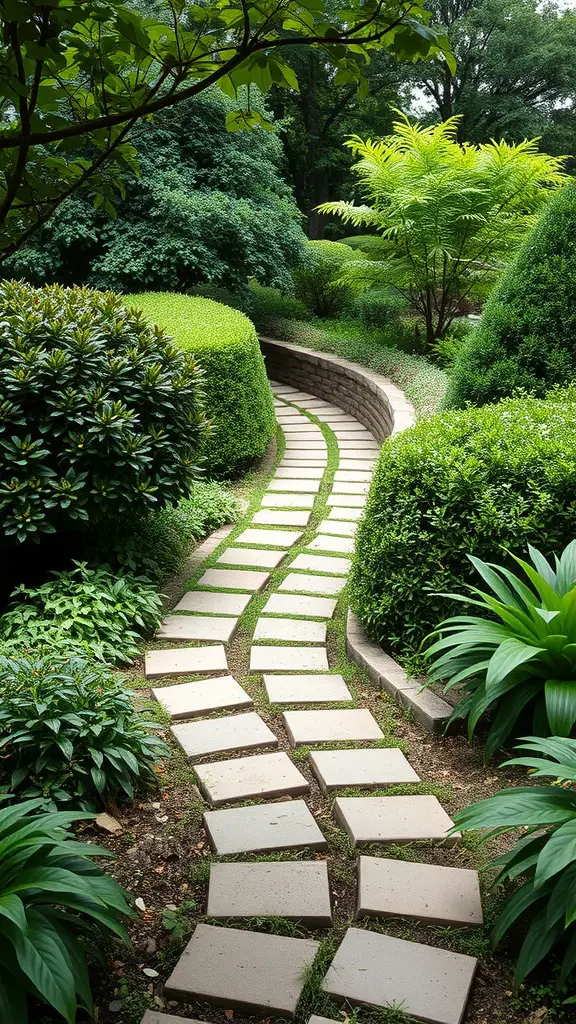
Creating a small garden layout can be a fun project, especially when you think about how pathways can shape the space. The image shows a winding pathway made of stone slabs, leading through lush greenery. This design invites you to stroll and explore the garden.
Pathways serve a practical purpose, guiding visitors through your garden while also adding visual interest. The gentle curves of the path in the image create a sense of flow, making the garden feel more inviting. You can use similar designs to break up areas and create distinct zones within your small garden.
Consider using materials that blend well with your plants. The stone slabs here complement the greenery beautifully. You might also think about adding some ground cover between the stones to enhance the natural look. This can soften the pathway and make it feel more integrated with the garden.
Lighting along the path can add charm, especially for evening strolls. Simple solar lights or lanterns can guide the way and highlight your plants. Overall, pathways can transform a small garden into a delightful retreat.
Maximizing Vertical Space
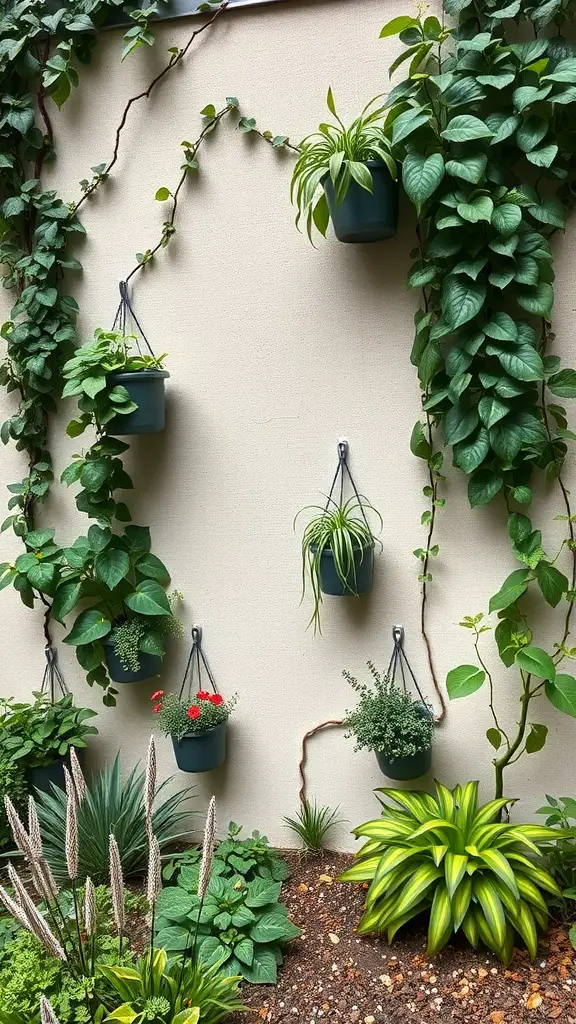
In small gardens, every inch counts. Using vertical space can really help you make the most of your area. The image shows a clever arrangement of hanging pots and climbing plants against a wall. This setup not only saves ground space but also adds a beautiful green backdrop.
The pots are filled with various plants, including vibrant flowers and lush greenery. They are suspended in a way that allows for easy access and care. The trailing vines create a natural flow, making the wall come alive with color and texture.
Incorporating vertical elements like this can transform a plain wall into a stunning feature. It encourages creativity in plant selection and arrangement. You can mix and match different types of plants to create visual interest. Plus, it’s a great way to add more plants without needing a larger footprint.
Consider using wall-mounted planters or trellises to achieve a similar look. This approach not only maximizes your garden’s potential but also enhances its overall beauty. So, if you’re working with limited space, think up, and let your garden grow vertically!
Incorporating Edible Plants
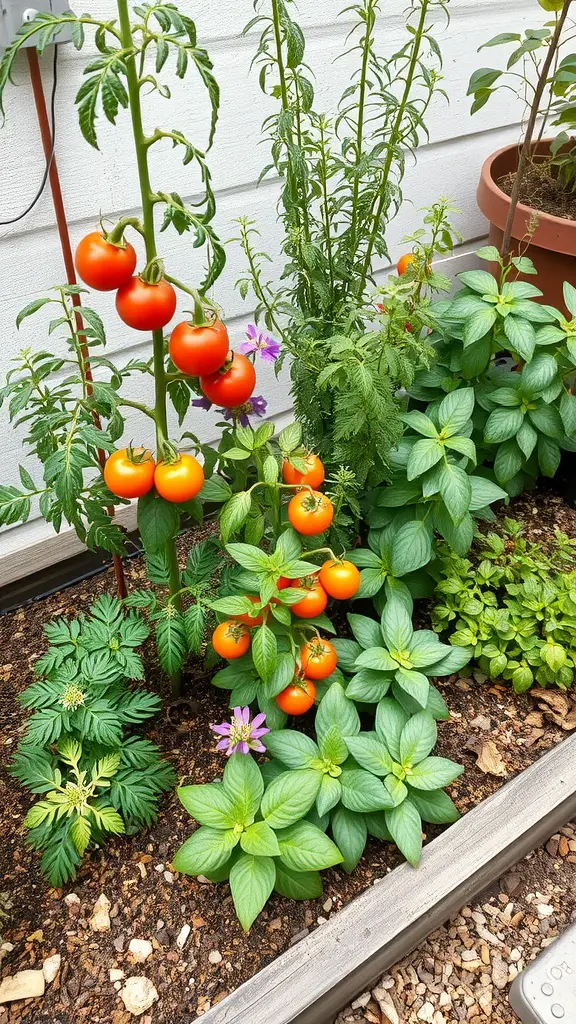
Creating a small garden can be a delightful way to grow your own food. The image shows a vibrant garden bed filled with lush green plants and ripe tomatoes. These tomatoes are not just for show; they are a delicious addition to any meal.
When planning your garden, think about mixing edible plants with ornamental ones. The tomatoes in the image are surrounded by various herbs and flowers, which not only look great but also attract beneficial insects. This combination can enhance your garden’s productivity while keeping it visually appealing.
Consider adding herbs like basil or mint alongside your tomatoes. They pair well in recipes and can be easily harvested. You can also plant flowers that attract pollinators, helping your garden thrive. A small garden can be both functional and beautiful!
Creating Seasonal Interest
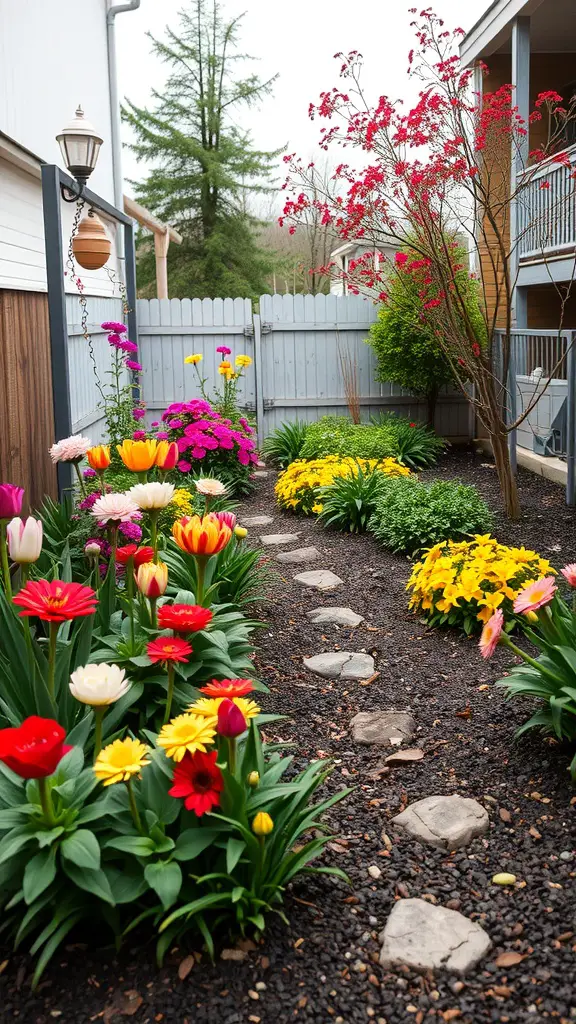
When designing a small garden, seasonal interest is key. The image shows a vibrant garden filled with colorful flowers, creating a cheerful atmosphere. The pathway made of stones invites you to explore this lovely space.
In spring, bright tulips and cheerful daisies bloom, bringing life to the garden. The mix of colors, like reds, yellows, and pinks, adds a playful touch. As seasons change, consider adding plants that will thrive in summer, like sunflowers and zinnias, to keep the garden lively.
Don’t forget about foliage! Evergreen plants can provide structure and greenery even in winter. This way, your garden remains appealing year-round. Incorporating seasonal plants ensures there’s always something new to enjoy, making your small garden a delightful retreat.
Implementing a Water Feature
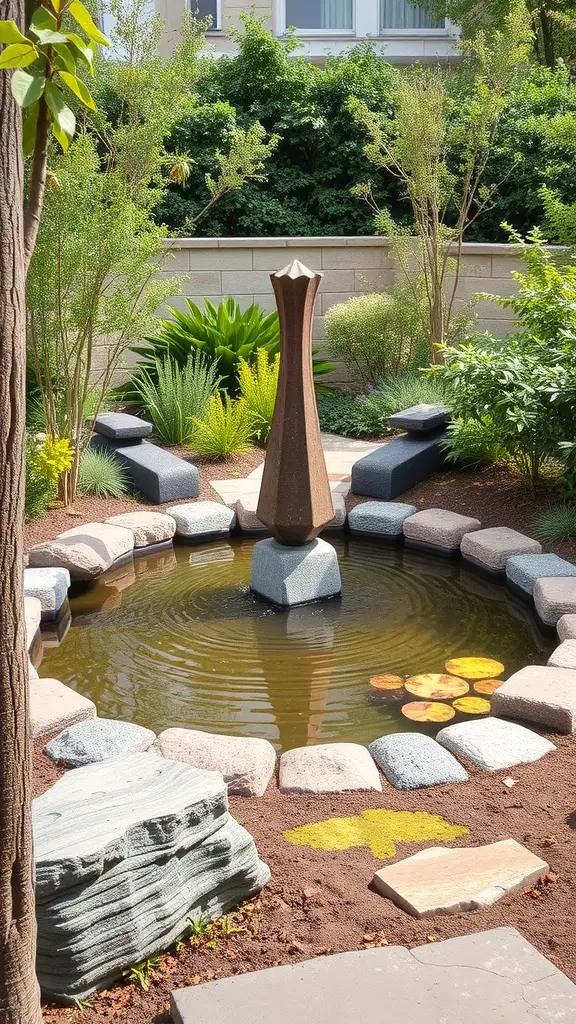
Adding a water feature to your small garden can create a calming atmosphere. The image shows a lovely pond surrounded by smooth stones and lush greenery. This setup not only looks great but also invites wildlife, like birds and butterflies, making your garden feel alive.
The centerpiece is a stylish fountain that adds movement and sound to the space. The gentle trickle of water can be soothing, perfect for relaxing after a long day. You can sit nearby and enjoy the peaceful vibes it brings.
Consider the layout of your garden when placing the water feature. It should be visible from your seating area to maximize enjoyment. Surrounding the pond with plants can enhance its beauty and provide a natural look. Choose plants that thrive in your climate for the best results.
Don’t forget about maintenance! Regularly check the water levels and clean the fountain to keep it looking fresh. With a little care, your water feature will be a stunning focal point in your small garden.
Using Color Schemes Effectively
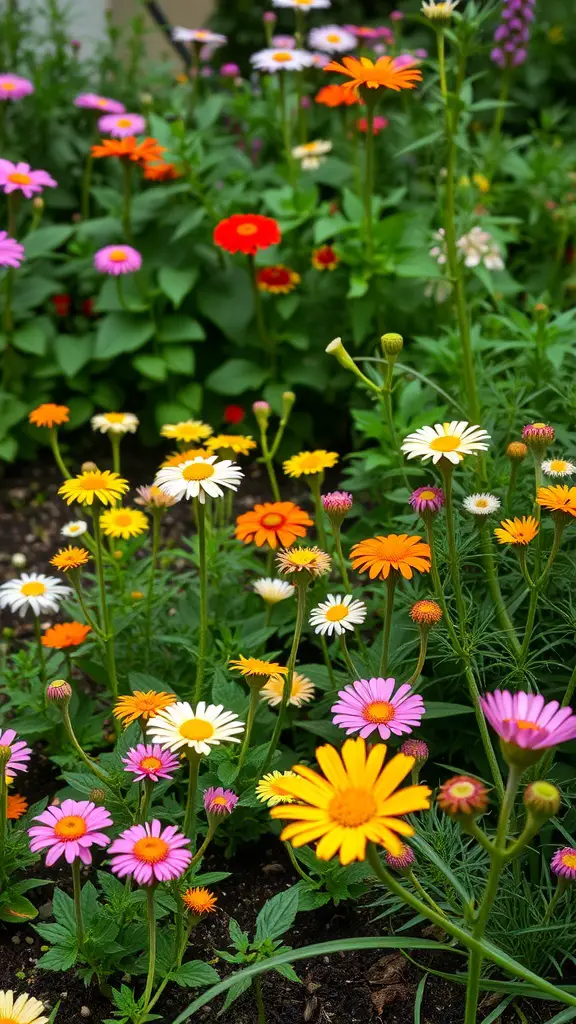
Color plays a big role in how a small garden feels. In the image, you can see a lively mix of flowers in vibrant hues like orange, pink, and yellow. These colors not only catch the eye but also create a cheerful atmosphere.
When planning your garden, think about how colors interact. For example, pairing warm colors like reds and oranges can create a cozy vibe. On the other hand, cool colors like blues and purples offer a calming effect. Mixing these can add depth and interest.
Consider the seasons too. Some flowers bloom in spring while others shine in summer. By choosing a variety of colors that bloom at different times, you can keep your garden looking fresh and inviting all year round.
Don’t forget about the greenery! The lush green leaves in the image provide a beautiful backdrop, allowing the colorful flowers to stand out. Incorporating different shades of green can enhance the overall look of your garden.
Utilizing Shade-Tolerant Plants
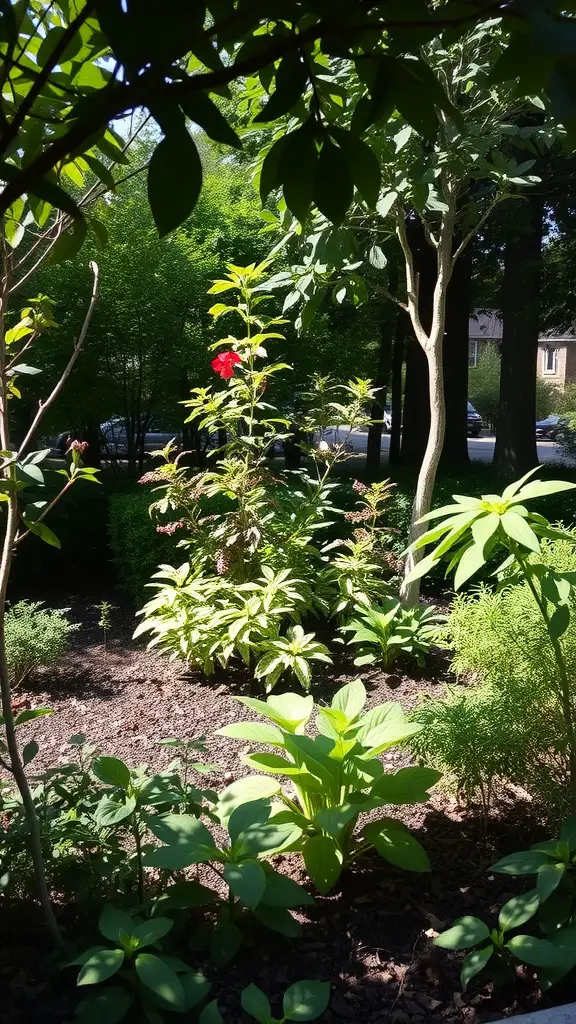
Creating a small garden can be a fun way to bring life to your outdoor space. In this image, we see a lovely arrangement of shade-tolerant plants thriving under the canopy of trees. These plants not only add beauty but also make the most of the limited sunlight available.
Notice the vibrant green leaves and the splash of color from the flowering plants. This combination creates a welcoming atmosphere. Shade-tolerant plants like hostas and ferns are perfect for these conditions, as they flourish in lower light.
When planning your garden, think about layering your plants. Taller plants can be placed in the back, while shorter ones fill in the front. This layout maximizes visual interest and ensures that every plant gets its share of attention, even in a small space.
Don’t forget to consider the soil and moisture needs of your plants. Shade-tolerant varieties often prefer rich, well-drained soil. Adding mulch can help retain moisture and keep the roots cool. With a little planning, your small garden can become a serene retreat filled with lush greenery.
Incorporating Wildlife-Friendly Elements

Creating a small garden can be a delightful way to connect with nature. In this vibrant space, colorful flowers bloom alongside unique plants, making it a haven for local wildlife. The bright red and yellow birdhouses hanging from the branches add a playful touch while inviting birds to visit.
These birdhouses not only serve as charming decorations but also provide shelter for feathered friends. Having birds around can help with pest control, as they eat insects that might harm your plants. Plus, their songs bring joy to any garden.
Incorporating native plants is another great way to attract wildlife. These plants are well-suited to the local environment and provide food and shelter for various creatures. The mix of flowers seen in the image offers nectar for butterflies and bees, supporting pollination.
Adding elements like a small water feature or a few rocks can create more habitats for insects and small animals. Even a simple dish of water can make a big difference. By making these small changes, your garden can become a lively ecosystem that benefits both you and the wildlife around you.
Designing for Privacy
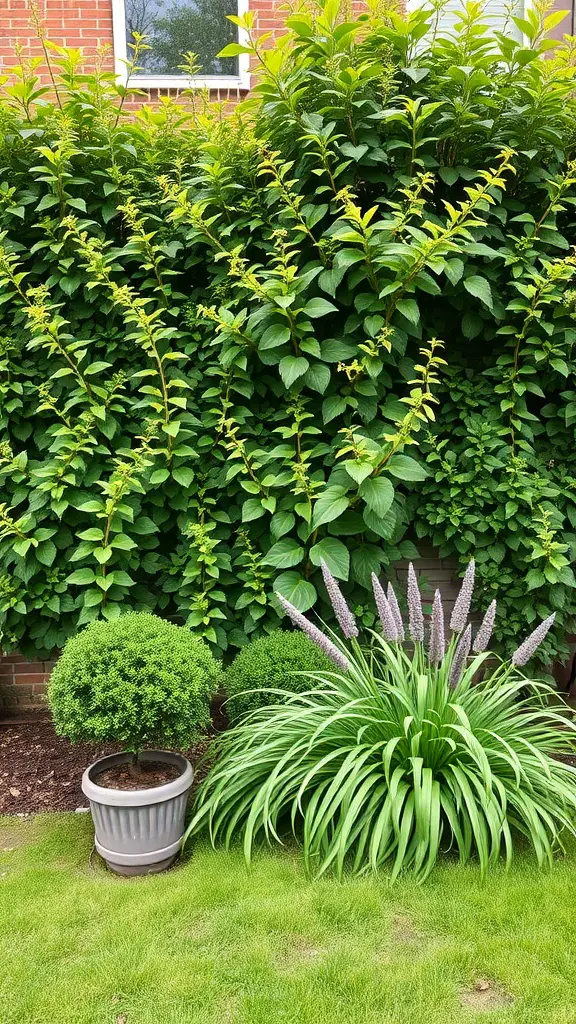
Creating a private space in your garden can make a big difference in how you enjoy it. In the image, we see a lush green backdrop formed by tall shrubs. This natural barrier is perfect for blocking out noise and prying eyes, allowing you to relax in peace.
The carefully placed plants, including rounded topiaries and vibrant flowers, add charm while enhancing privacy. The greenery not only looks good but also serves as a shield, making your garden feel more secluded.
When designing for privacy, think about the height and density of your plants. Taller shrubs can provide a solid wall, while lower plants can add layers and texture. This combination creates a cozy atmosphere, ideal for unwinding or entertaining.
Incorporating elements like planters can also help define spaces within your garden. The gray planter in the image adds a modern touch while supporting the overall theme of privacy. With thoughtful planning, you can transform your garden into a private retreat.
Creating a Themed Garden
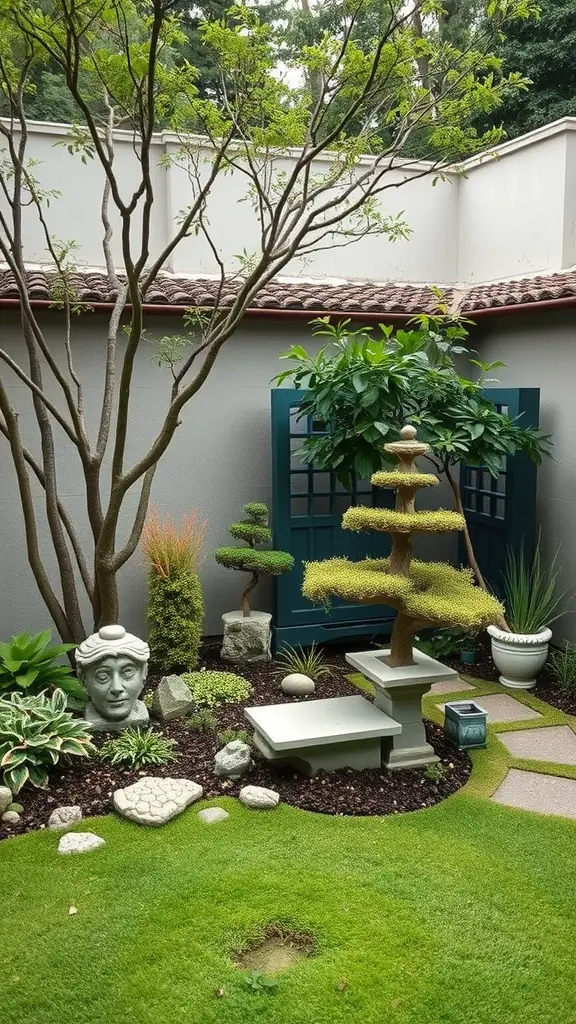
Creating a themed garden can turn a small space into a delightful retreat. The image shows a serene garden layout that combines various elements to evoke a peaceful atmosphere.
Notice the carefully trimmed bonsai trees that add a touch of elegance. They serve as focal points, drawing the eye and inviting exploration. The stone features, including the head sculpture and stepping stones, enhance the garden’s charm and provide texture.
The lush greenery and vibrant plants create a refreshing vibe. The mix of colors and shapes makes the garden feel alive and inviting. The soft grass underfoot adds comfort, making it a perfect spot to relax.
Incorporating a small seating area, like the stone bench, encourages you to sit back and enjoy the beauty around you. This layout shows how even a compact space can be transformed into a themed haven.
Incorporating Lighting Features
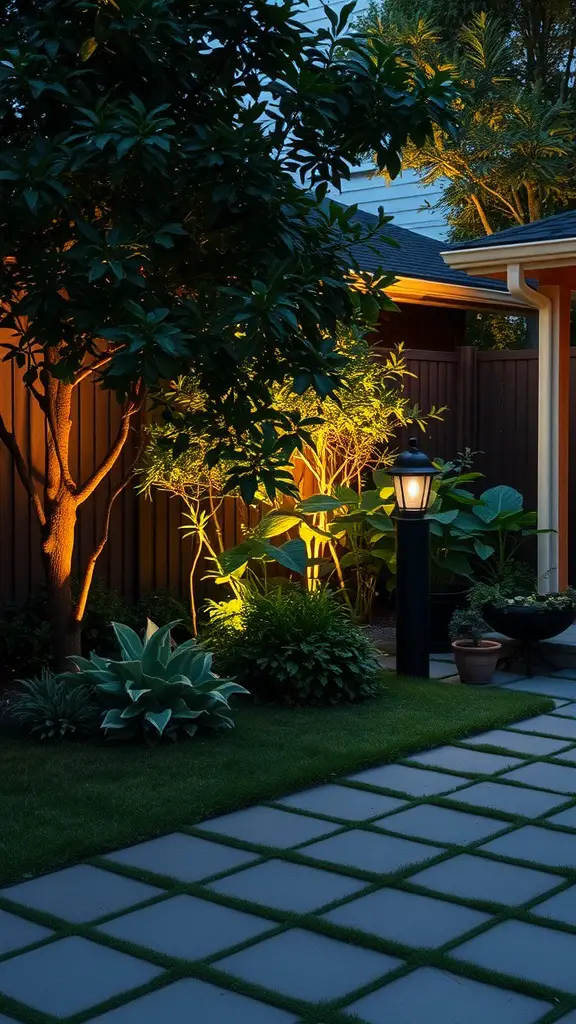
Lighting can truly transform a small garden. Imagine stepping into your outdoor space at night, greeted by soft, warm lights that highlight the beauty of your plants and pathways.
In the image, we see a lovely garden layout with a mix of greenery and well-placed lighting. The gentle glow from the lamp adds character, making the space feel inviting. This kind of lighting not only enhances the visual appeal but also creates a cozy atmosphere for evening gatherings.
Using lights strategically can guide guests along pathways and draw attention to specific plants or features. For instance, uplighting on trees or shrubs can create a stunning focal point. It’s all about finding the right balance to make your garden shine without overwhelming it.
Consider using solar lights for an eco-friendly option. They’re easy to install and come in various styles to match your garden’s theme. Whether you prefer modern fixtures or classic lanterns, there’s something for every taste.
Incorporating lighting features in your small garden can elevate its charm and make it a delightful retreat, day or night.
Incorporating Fragrance
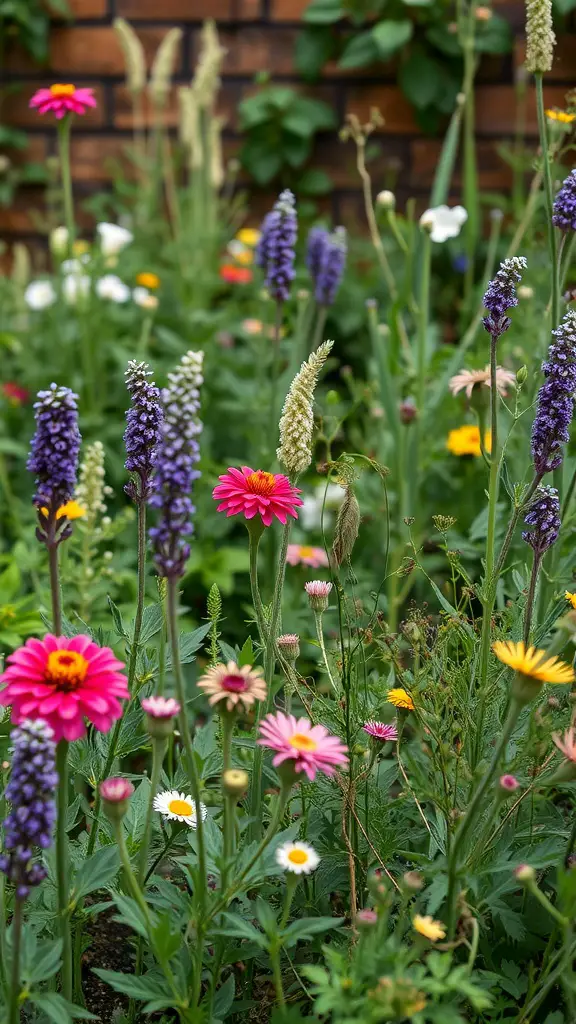
Creating a small garden is not just about the visuals; it’s also about the scents. The image showcases a vibrant mix of flowers, each contributing its unique aroma. Imagine stepping into this garden and being greeted by the sweet smell of blooming zinnias and the fresh scent of lavender. These fragrances can uplift your mood and create a peaceful atmosphere.
When planning your small garden layout, think about how different plants can complement each other. For instance, pairing fragrant herbs like rosemary or mint with colorful flowers can enhance the sensory experience. Not only do these herbs smell wonderful, but they can also be used in cooking!
Consider planting flowers that bloom at different times to ensure a continuous fragrance throughout the seasons. Spring might bring the delightful scent of lilacs, while summer can be filled with the sweet notes of gardenias. This way, your garden remains a fragrant retreat all year long.
Using Ground Covers Wisely
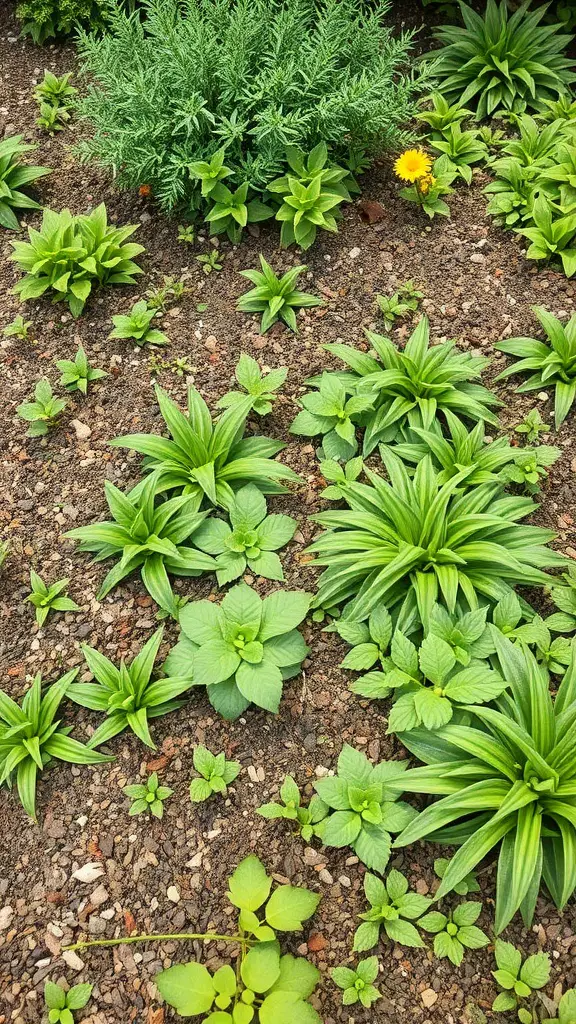
Ground covers are a fantastic way to fill in spaces in your garden. They help prevent weeds and keep the soil moist. In the image, you can see a variety of ground covers that create a lush, green carpet. Each plant has its own unique shape and texture, adding interest to the layout.
When choosing ground covers, think about the sunlight and moisture levels in your garden. Some plants thrive in shade, while others need full sun. The plants in the image show a mix of textures, from the soft leaves of the lower plants to the more upright forms behind them. This variety can make your garden visually appealing.
Ground covers can also help with erosion control. Their roots hold the soil in place, especially on slopes. In smaller gardens, using ground covers wisely can maximize your space and create a beautiful, low-maintenance area.
Designing for Accessibility
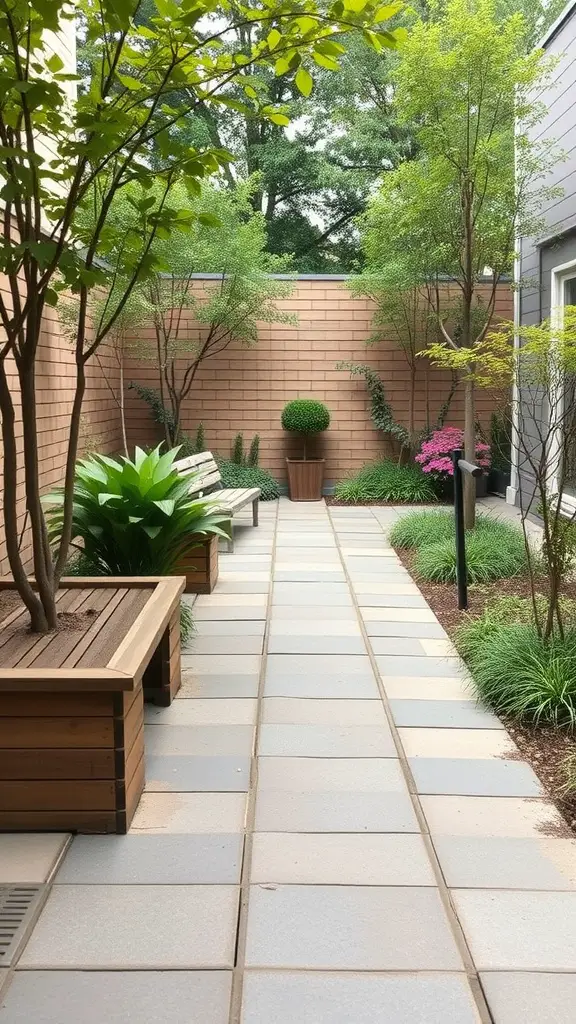
Creating a small garden can be a delightful experience, especially when you focus on accessibility. The image shows a well-planned garden layout that emphasizes ease of movement. Notice the wide, paved pathway that allows for smooth navigation, making it friendly for everyone, including those with mobility challenges.
The benches on either side provide resting spots, encouraging visitors to pause and enjoy the surroundings. The plants are thoughtfully placed, ensuring they don’t obstruct the walkway. This layout not only enhances the garden’s beauty but also makes it more inviting.
Accessibility in garden design means considering the needs of all users. The use of low-maintenance plants and clear pathways can make a garden easier to care for and enjoy. This approach ensures that everyone can appreciate the space, regardless of their physical abilities.
Creating a Child-Friendly Space
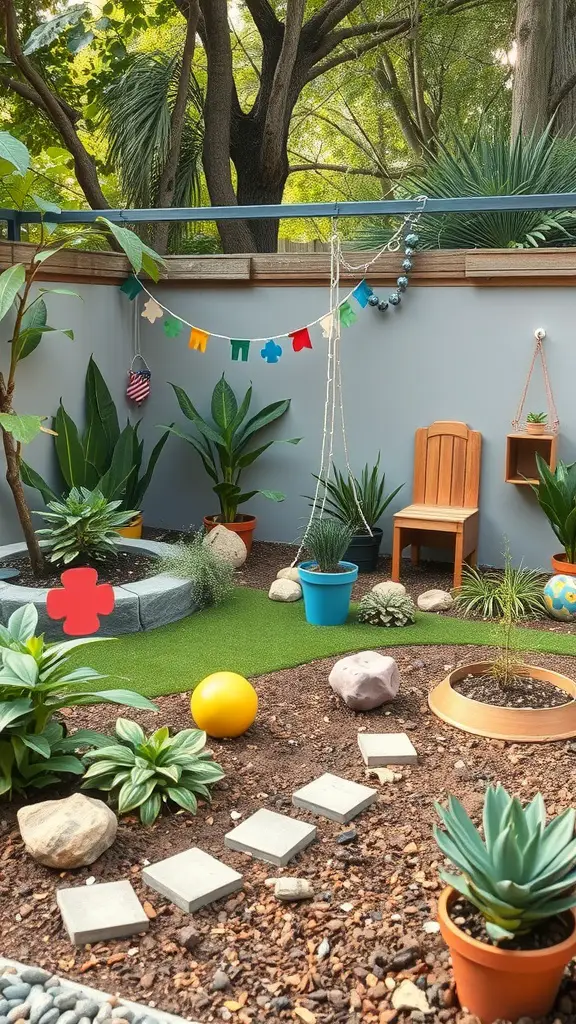
Designing a small garden for kids can be a fun and rewarding project. This image shows a vibrant garden layout that is perfect for children. The space is filled with colorful elements that invite play and exploration.
The garden features soft, green turf that provides a safe area for kids to run around. Brightly colored balls and playful decorations add a cheerful touch. The use of natural materials, like stones and plants, creates a lively environment that sparks curiosity.
Incorporating seating, like the wooden chair shown, allows for relaxation and storytelling. The playful decorations, such as the colorful garland, make the space feel welcoming and fun. This garden layout encourages children to engage with nature while having a great time.
Utilizing Seasonal Containers
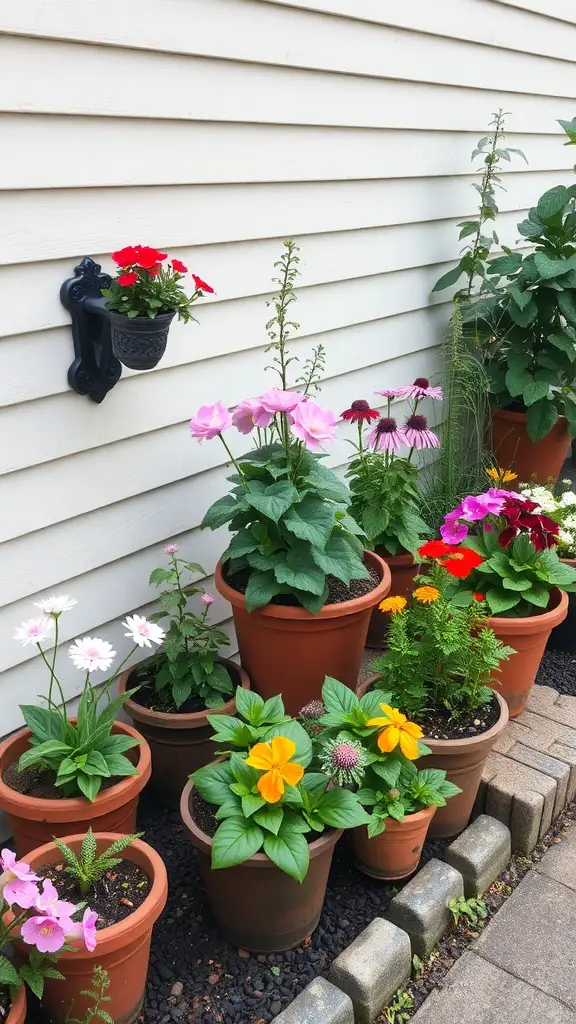
Seasonal containers can bring life to any small garden. The image shows a lovely arrangement of potted plants against a simple wall. Each pot is filled with colorful flowers, creating a cheerful vibe.
Using containers allows you to change the look of your garden easily. You can swap out plants based on the season. In spring, opt for bright blooms like petunias and daisies. Come summer, you might choose vibrant marigolds or zinnias.
Another great aspect of containers is their mobility. You can rearrange them to fit your mood or the season. If you have a sunny spot, move your sun-loving plants there. If the weather changes, simply bring them inside or to a sheltered area.
Don’t forget about the height and texture of your plants. Mixing tall and short plants creates visual interest. Adding some greenery, like ferns or trailing vines, can enhance the overall look.
Lastly, consider the color scheme. Pair complementary colors for a striking effect or go for a monochromatic look for a more subtle approach. Seasonal containers are a fun way to express your style while keeping your small garden fresh and inviting.
Implementing Sustainable Practices
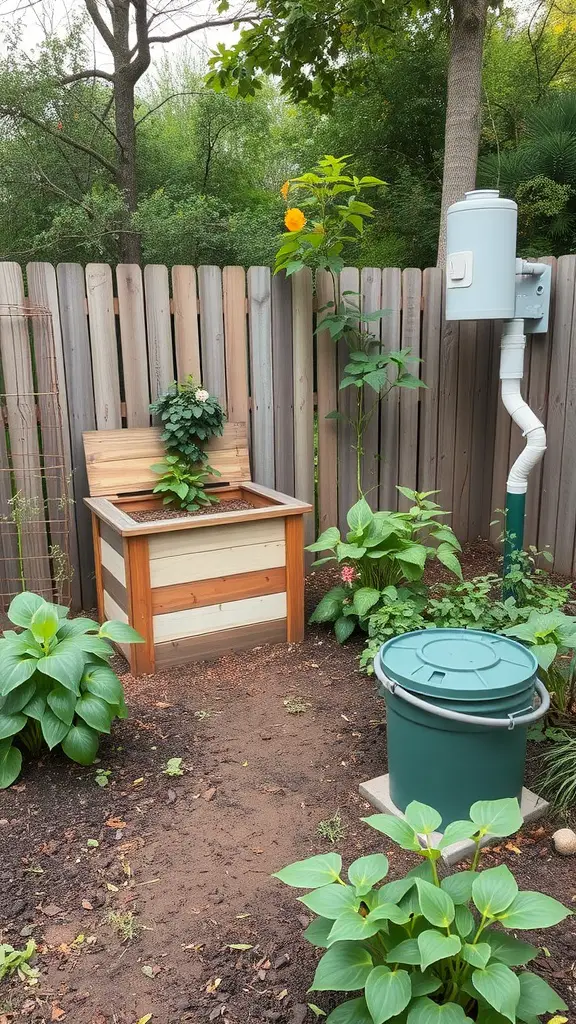
Creating a small garden can be a rewarding experience, especially when you incorporate sustainable practices. The image shows a well-organized garden layout featuring a raised planter box, surrounded by lush greenery. This setup not only looks inviting but also promotes eco-friendly gardening.
The raised planter box is a great way to grow your plants while minimizing soil compaction. It allows for better drainage and can be filled with nutrient-rich soil. This method helps in conserving water and reducing the need for chemical fertilizers.
Next to the planter, you can see a compost bin. Composting is a fantastic way to recycle kitchen scraps and yard waste. It enriches the soil and reduces landfill waste. By using compost, you can nourish your plants naturally, which is a key aspect of sustainable gardening.
Surrounding the garden are various plants that contribute to biodiversity. Choosing native plants can attract beneficial insects and pollinators, creating a balanced ecosystem. This not only supports local wildlife but also enhances the overall health of your garden.
Incorporating these sustainable practices in your small garden layout can lead to a thriving green space that benefits both you and the environment.

